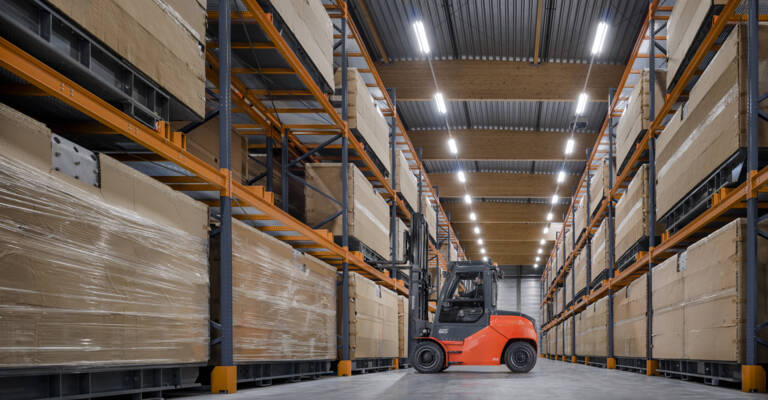Matching Your Used Forklift with Your Aisle Layout
The Raymond Corporation revolutionized forklift design in 1951 when the company introduced the first Narrow Aisle (NA) forklift. Because outriggers beneath the forks eliminated the need for a bulky counterbalance at the rear of the lift truck, NA forklifts were more compact than their predecessors. This enabled factories and warehouses to maximize their available space, making day-to-day operations more efficient and cost-effective.
Over the ensuing years, forklift designs were refined even further and Very Narrow Aisle (VNA) forklifts came on to the market. By the time the dust settled, there were so many classes and codes of forklifts available, that choosing a new or used forklift became far more difficult than simply deciding between an electric vs an IC forklift and how much carrying capacity you required. You probably don’t need to hire a logistics expert to help you with your aisle layout and choice of used forklifts, but a little knowledge can help you make some common mistakes.
Calculating Counterbalanced Forklift Aisle Space
By definition, counterbalanced forklifts are “wide aisle” forklifts. How wide is “wide”? That depends on your forklift and the load it’s carrying. Here’s a simple way to calculate your used counterbalanced forklift aisle space requirements:
1. Measure the length of the lift truck from the back of the truck to the front of the load backrest (this is the “head length”).
2. Add the length of the pallet from front to back plus any load overhang.
3. Add an extra 6 inches for pallet overhang.
4. Add 12 inches for maneuverability.
As a rule, counterbalanced 4-wheel lift trucks require 12 to 14-foot aisle widths; 3-wheeled forklifts need 11 to 12-foot aisles, and stand-up counterbalanced forklifts can get by in aisles between 10.5 and 11.5 feet.
Calculating Narrow Aisle Forklift Aisle Space

Image courtesy of Toyota Forklift – Bahrns ToyotaLift is an award-winning Toyota Forklift Dealership
Because they are designed for specific aisle widths, the specifications of NA forklifts include recommended aisle widths. However, minimizing the aisle width necessary to safely and efficiently maneuver NA forklifts is a matter of technique and skill. As a rule, NA forklifts are designed for operation in 9-foot wide aisles. Some large warehousing facilities have managed to reduce that to 8.5 feet, but they do so at the expense of time. If maximizing storage space is your priority, then this may be advisable, but that extra half-foot of aisle space is not worth it in the average warehouse or factory.
If you’re looking for a reconditioned or used forklift, odds are you don’t have precise aisle requirements, but there is a big difference between the 12 to 14 feet required for a 4-wheel counterbalanced lift truck and the 9 feet of aisle space you need for a narrow aisle forklift. In a small to medium-sized material handling facility, those extra few feet per aisle can make the difference between a cost-effective and a costly facility.
Consider buying a used NA forklift if:
• Storage space is limited in your facility.
• Workspace is cramped in your factory or warehouse.
• Your counterbalanced forklift is too frequently taken away from other jobs to handle materials on your pallet racks.
Find out how to Maximize Warehouse Space with Narrow Aisle Forklifts on reconditionedforklifts.com.
We at reconditionedforklifts.com are part of the Bahrns Equipment team of material handling experts. With over 40 years of experience behind us, we can help you decide which used forklift will work best in your situation. Just contact us and talk to one of our in-house customer representatives and they will be happy to help you with any questions you have about the reconditioned and used forklifts you find in our inventory.

